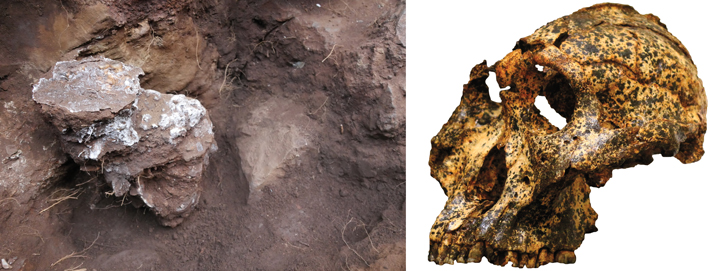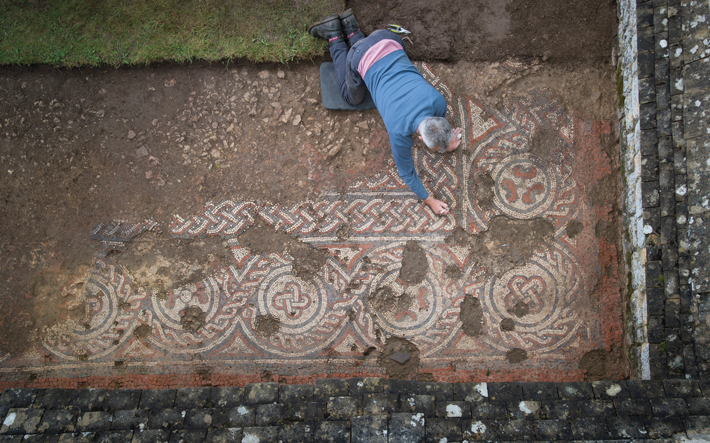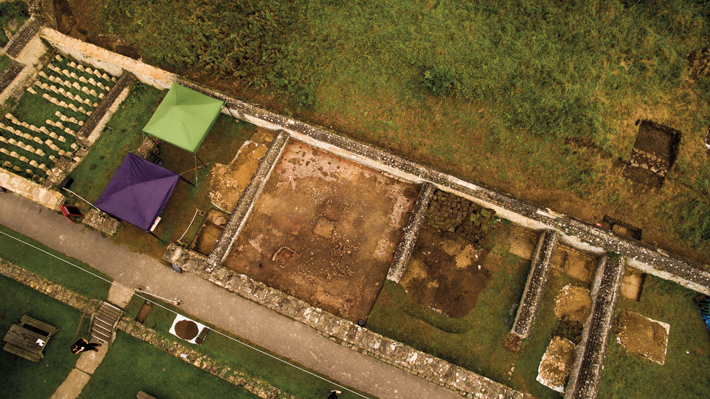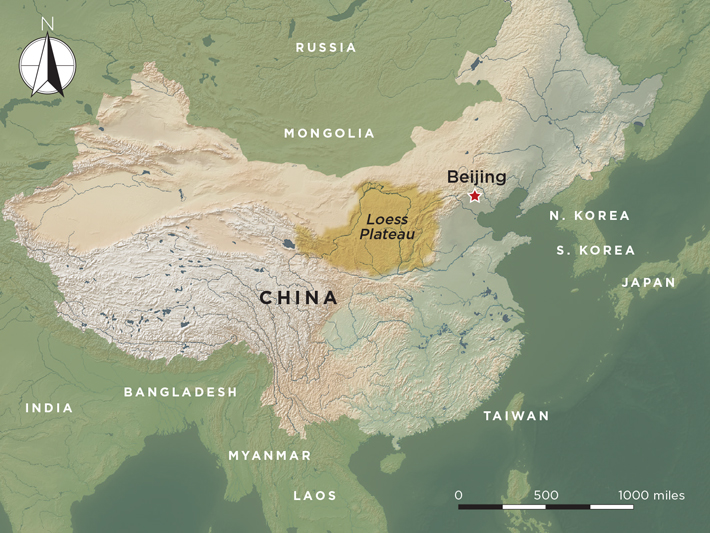Digs & Discoveries
Consider the Craniums
By ERIC A. POWELL
Friday, April 09, 2021
 The two-million-year-old skull of a male hominin unearthed in the Drimolen Main Quarry north of Johannesburg has changed how scholars imagine one of our distant human cousins. The skull, dubbed DNH 155, belongs to the earliest known and best-preserved member of the species Paranthropus robustus, a small-brained hominin that lived around the same time as Homo erectus, our direct human ancestor. P. robustus had large, powerful teeth that had evolved to eat tough food such as tubers and bark. The species was thought to have been highly sexually dimorphic, meaning that males and females were drastically different in size and build. Paleoanthropologists had drawn that conclusion because the exclusively female skulls discovered at Drimolen Main Quarry were much smaller than those of male skulls discovered at nearby Swartkrans Cave, which date to 200,000 years later. But the male DNH 155 cranium, while somewhat larger than female skulls at Drimolen Main Quarry, is much smaller than P. robustus skulls from Swartkrans Cave. “DNH 155 is the final nail in the coffin for the sexual dimorphism hypothesis,” says La Trobe University anthropologist Jesse Martin, who co-led the team that discovered and analyzed the skull. The team now believes that the size difference between the P. robustus skulls at Drimolen Main Quarry and Swartkrans Cave resulted from adaptations to a changing environment over the few hundred thousand years that separated them.
The two-million-year-old skull of a male hominin unearthed in the Drimolen Main Quarry north of Johannesburg has changed how scholars imagine one of our distant human cousins. The skull, dubbed DNH 155, belongs to the earliest known and best-preserved member of the species Paranthropus robustus, a small-brained hominin that lived around the same time as Homo erectus, our direct human ancestor. P. robustus had large, powerful teeth that had evolved to eat tough food such as tubers and bark. The species was thought to have been highly sexually dimorphic, meaning that males and females were drastically different in size and build. Paleoanthropologists had drawn that conclusion because the exclusively female skulls discovered at Drimolen Main Quarry were much smaller than those of male skulls discovered at nearby Swartkrans Cave, which date to 200,000 years later. But the male DNH 155 cranium, while somewhat larger than female skulls at Drimolen Main Quarry, is much smaller than P. robustus skulls from Swartkrans Cave. “DNH 155 is the final nail in the coffin for the sexual dimorphism hypothesis,” says La Trobe University anthropologist Jesse Martin, who co-led the team that discovered and analyzed the skull. The team now believes that the size difference between the P. robustus skulls at Drimolen Main Quarry and Swartkrans Cave resulted from adaptations to a changing environment over the few hundred thousand years that separated them.
After the Fall
By DANIEL WEISS
Friday, April 09, 2021
 It has long been thought that when Roman rule of Britain ended in the early fifth century A.D., the population retreated to the countryside to eke out a living through subsistence farming. But new dating of a mosaic at Chedworth Roman Villa in Gloucestershire suggests that at least some continued to appreciate the finer things. Radiocarbon dating of charcoal and bone found in a trench dug to build one of the walls of the room where the mosaic was laid down shows that the fancy flooring was crafted in the mid-fifth century A.D. “It’s really exciting to imagine that these people carried on a Romanized way of life and that crafts like mosaic making survived,” says National Trust archaeologist Martin Papworth.
It has long been thought that when Roman rule of Britain ended in the early fifth century A.D., the population retreated to the countryside to eke out a living through subsistence farming. But new dating of a mosaic at Chedworth Roman Villa in Gloucestershire suggests that at least some continued to appreciate the finer things. Radiocarbon dating of charcoal and bone found in a trench dug to build one of the walls of the room where the mosaic was laid down shows that the fancy flooring was crafted in the mid-fifth century A.D. “It’s really exciting to imagine that these people carried on a Romanized way of life and that crafts like mosaic making survived,” says National Trust archaeologist Martin Papworth.

You Are How You Cook
By JARRETT A. LOBELL
Friday, April 09, 2021
 It turns out that what you eat may have as much to do with how you cook as with what’s available at the farmers market. In Bronze Age China, established cooking styles had a profound impact on the speed with which new domesticated crops were adopted into regional cuisines, says archaeologist Xinyi Liu of Washington University in St. Louis. “There is a deep-seated divide between eastern and western cooking preferences in China: boiling and steaming in the east, and grinding and baking in the west,” Liu explains. “When grains like wheat and barley, which are rooted in the grinding and baking tradition, enter a cuisine that favors boiling and steaming and eating whole grains, what’s going to happen?” Will people accustomed to beginning their day with a steaming bowl of millet porridge suddenly start making toast instead?
It turns out that what you eat may have as much to do with how you cook as with what’s available at the farmers market. In Bronze Age China, established cooking styles had a profound impact on the speed with which new domesticated crops were adopted into regional cuisines, says archaeologist Xinyi Liu of Washington University in St. Louis. “There is a deep-seated divide between eastern and western cooking preferences in China: boiling and steaming in the east, and grinding and baking in the west,” Liu explains. “When grains like wheat and barley, which are rooted in the grinding and baking tradition, enter a cuisine that favors boiling and steaming and eating whole grains, what’s going to happen?” Will people accustomed to beginning their day with a steaming bowl of millet porridge suddenly start making toast instead?
Liu began his work by examining perhaps the key episode in the history of food, the period of globalization from roughly 7,000 to 3,500 years ago when domesticated cereals and animals moved from east to west and vice versa across Eurasia. “At the center of this narrative is the eastward dispersal of the so-called Fertile Crescent founder crops, such as durum wheat and barley, from the Near East to East Asia,” explains Liu. “In the opposite direction, there was the movement of broomcorn and foxtail millets from China to the west.” Liu wanted to go beyond the mechanisms of these global food movements to investigate how existing culinary traditions influenced the adoption of these novel foods.
Liu analyzed isotopes in the bones of individuals from 128 sites across China dating to before the end of the Han Dynasty in A.D. 220. He demonstrated that people in eastern China on the Loess Plateau, where smaller grains such as millet were easier to cook using that region’s traditional boiling and steaming methods, were much slower to adopt wheat and barley than were those in the west. Indeed, these larger grains were not adopted as dietary staples in parts of China until the end of the first millennium B.C. Liu says that this phenomenon can’t be explained simply by when grains arrived in a given area or by environmental factors. Instead, it was likely influenced by preferred cooking styles. “Prehistoric farmers probably selected more compact wheat grains in order to cook them in the same way as they cooked millet meals,” Liu says. His study found extensive evidence that novel grains were incorporated into existing practices of food preparation at different rates. “This resonates with our own daily experience of cooking,” he says. “It’s always easy to add new flavors, but it’s difficult to change the basic cooking method.”
 Changes in what people consume can also move slowly due to the communicative aspect of food and its connection to social relationships. “There are two aspects of food,” Liu says, “a technical and physical aspect, which is normally about fulfilling biological needs, and an expressive and communicative aspect, which says something.” As an example, Liu imagines a scenario in which you are invited to someone’s house for dinner but served a typical breakfast meal. “You won’t feel hungry afterward,” he says, “but it’s socially awkward. The biological aspect is fulfilled, but the communicative aspect is wrongly structured. We also use meals to structure our days. On those days when you don’t have any lunch, not only is your body stressed, but the afternoon feels different.” The communicative aspect of food is always a conservative force, Liu explains, and the initial rejection of wheat and barley as staple grains in eastern China hints at this—these novel grains didn’t mesh well with the social dimensions of the area’s traditional culinary systems.
Changes in what people consume can also move slowly due to the communicative aspect of food and its connection to social relationships. “There are two aspects of food,” Liu says, “a technical and physical aspect, which is normally about fulfilling biological needs, and an expressive and communicative aspect, which says something.” As an example, Liu imagines a scenario in which you are invited to someone’s house for dinner but served a typical breakfast meal. “You won’t feel hungry afterward,” he says, “but it’s socially awkward. The biological aspect is fulfilled, but the communicative aspect is wrongly structured. We also use meals to structure our days. On those days when you don’t have any lunch, not only is your body stressed, but the afternoon feels different.” The communicative aspect of food is always a conservative force, Liu explains, and the initial rejection of wheat and barley as staple grains in eastern China hints at this—these novel grains didn’t mesh well with the social dimensions of the area’s traditional culinary systems.
Liu hopes that further study will also enable researchers to better explore how men and women ate differently. “Food habits and culinary traditions are often related to kinship and family structure and sometimes gender,” he explains. “An interesting finding from our study is that the newly introduced crops from the Near East were, at least in some parts of China, consumed by females to a greater degree than males, hinting that women were the primary pioneers of culinary innovation.”
Advertisement
Advertisement
IN THIS ISSUE
Digs & Discoveries
You Are How You Cook
After the Fall
Consider the Craniums
Ship of Ivory
Money Talks
Heads of the Family
Mistaken Identity
Beast Masters
Swan Songs
A Welsh Ancestor
Artemis, Apollo, and Friends
A Twin Burial
Off the Grid
Around the World
Chumash currency, resisting the Russians in Alaska, conversing with Osiris, and an Aztec golden eagle
Artifact
In tune with the times
Advertisement

Recent Issues
-
 May/June 2024
May/June 2024
-
 March/April 2024
March/April 2024
-
 January/February 2024
January/February 2024
-
 November/December 2023
November/December 2023
-
 September/October 2023
September/October 2023
-
 July/August 2023
July/August 2023
-
 May/June 2023
May/June 2023
-
 March/April 2023
March/April 2023
-
 January/February 2023
January/February 2023
-
 November/December 2022
November/December 2022
-
 September/October 2022
September/October 2022
-
 July/August 2022
July/August 2022
-
 May/June 2022
May/June 2022
-
 March/April 2022
March/April 2022
-
 January/February 2022
January/February 2022
-
 November/December 2021
November/December 2021
-
 September/October 2021
September/October 2021
-
 July/August 2021
July/August 2021
-
 May/June 2021
May/June 2021
-
 March/April 2021
March/April 2021
-
 January/February 2021
January/February 2021
-
 November/December 2020
November/December 2020
-
 September/October 2020
September/October 2020
-
 July/August 2020
July/August 2020
-
 May/June 2020
May/June 2020
-
 March/April 2020
March/April 2020
-
 January/February 2020
January/February 2020
-
 November/December 2019
November/December 2019
-
 September/October 2019
September/October 2019
-
 July/August 2019
July/August 2019
-
 May/June 2019
May/June 2019
-
 March/April 2019
March/April 2019
-
 January/February 2019
January/February 2019
-
 November/December 2018
November/December 2018
-
 September/October 2018
September/October 2018
-
 July/August 2018
July/August 2018
-
 May/June 2018
May/June 2018
-
 March/April 2018
March/April 2018
-
 January/February 2018
January/February 2018
-
 November/December 2017
November/December 2017
-
 September/October 2017
September/October 2017
-
 July/August 2017
July/August 2017
-
 May/June 2017
May/June 2017
-
 March/April 2017
March/April 2017
-
 January/February 2017
January/February 2017
-
 November/December 2016
November/December 2016
-
 September/October 2016
September/October 2016
-
 July/August 2016
July/August 2016
-
 May/June 2016
May/June 2016
-
 March/April 2016
March/April 2016
-
 January/February 2016
January/February 2016
-
 November/December 2015
November/December 2015
-
 September/October 2015
September/October 2015
-
 July/August 2015
July/August 2015
-
 May/June 2015
May/June 2015
-
 March/April 2015
March/April 2015
-
 January/February 2015
January/February 2015
-
 November/December 2014
November/December 2014
-
 September/October 2014
September/October 2014
-
 July/August 2014
July/August 2014
-
 May/June 2014
May/June 2014
-
 March/April 2014
March/April 2014
-
 January/February 2014
January/February 2014
-
 November/December 2013
November/December 2013
-
 September/October 2013
September/October 2013
-
 July/August 2013
July/August 2013
-
 May/June 2013
May/June 2013
-
 March/April 2013
March/April 2013
-
 January/February 2013
January/February 2013
-
 November/December 2012
November/December 2012
-
 September/October 2012
September/October 2012
-
 July/August 2012
July/August 2012
-
 May/June 2012
May/June 2012
-
 March/April 2012
March/April 2012
-
 January/February 2012
January/February 2012
-
 November/December 2011
November/December 2011
-
 September/October 2011
September/October 2011
-
 July/August 2011
July/August 2011
-
 May/June 2011
May/June 2011
-
 March/April 2011
March/April 2011
-
 January/February 2011
January/February 2011
Advertisement






